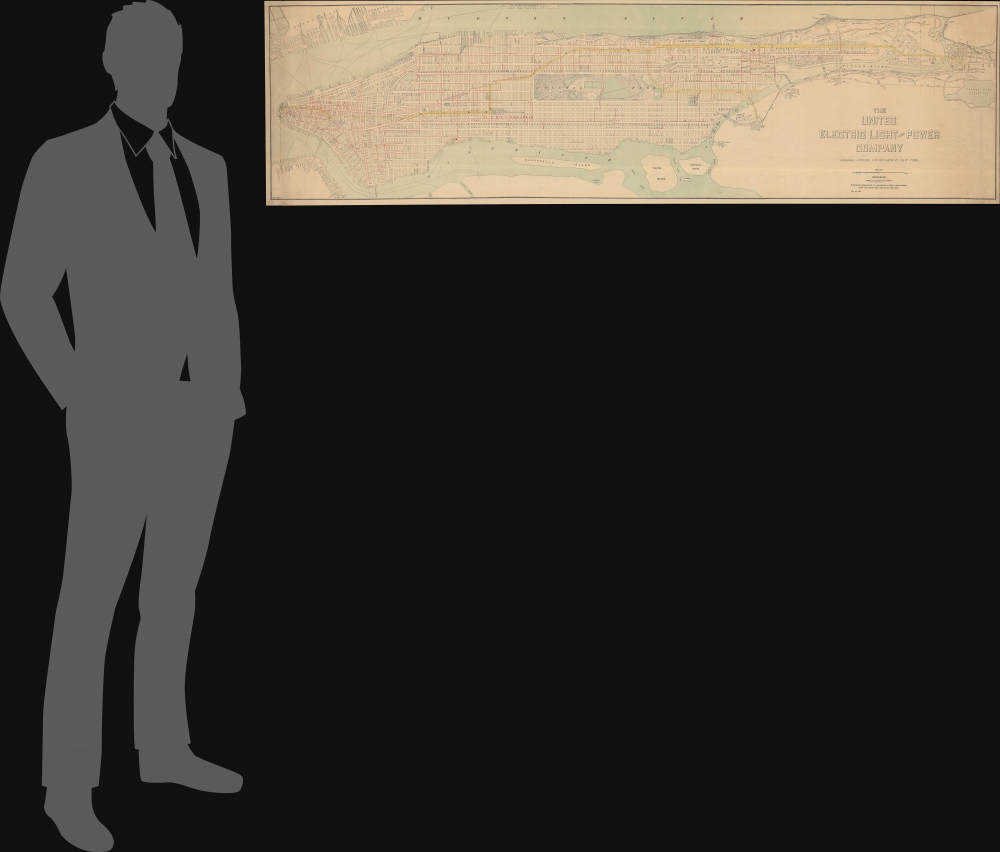1903 Monaghan / United Light Electric and Power Wall Map of Manhattan
ManhattanUnitedElectric-monaghan-1903
Title
1903 (dated) 16.25 x 61.25 in (41.275 x 155.575 cm) 1 : 14500
Description
A Closer Look
Displaying Manhattan, complete with street grid, and portions of Brooklyn, the Bronx, and New Jersey with partial street grids, along with portions of Queens and islands in the East River, this map traces the service mains of the United Electric Light and Power Company. The company's power station on E. 29th St. and a large substation on W. 146th St. are represented with red squares. The underground (Subway) lines seen here, traced in yellow, belong to the Interborough Rapid Transit Company; in fact, these lines were still under construction at the time and did not open to passengers until 1904. United Electric had a close relationship with the IRT, providing backup lighting along its tunnels on separate circuits. Other rail lines, streets, parks, ferry lines, bridges, and other features are labeled throughout.The United Electric Light and Power Company
The company which became United Electric Light and Power was founded in 1887 as Safety Electric Light and Power Company. It played an important role in the competition between direct and alternating current electrical systems, working with George Westinghouse in furtherance of the latter against the direct current systems promoted by Thomas Edison. The company came under Westinghouse's control and changed its name to United Electric Light and Power in 1889, when they were awarded the contract to install electric street lighting in Lower Manhattan. The company expanded aggressively in the 1890s, building a client base along the edges of Manhattan and the Bronx (Edison Electric Illuminating Company dominated central Manhattan).In the early 20th century, the trend was towards consolidation, and magnate Anthony N. Brady acquired United. However, it continued to maintain a distinct identity and operation. Among other things, it became known for its very large, brilliantly lighted advertising signs for Wrigley's Gum and Heatherbloom Petticoats. In 1907, the company's main power plant on E. 29th St. in Kips Bay was turned over to the city to construct a new building for Bellevue Hospital. The company opened a new power plant along the Harlem River, guaranteeing service to a growing customer base in Uptown Manhattan and the Bronx. They also built a plant at Hell Gate in the Bronx, which was, upon opening, the world's most powerful steam-operated power station.
Although mostly confined to residential customers in Uptown Manhattan and the Bronx, the company had an outsize influence, helping to settle the debate between direct and alternating current and convincing Matthew S. Sloan, the President of New York Edison, to abandon direct current in 1928. Between 1932 and 1935, United was merged into Edison to form the New York Edison Company, Inc. Though far less well-known than names like Westinghouse and Edison today, United Electric played an essential role in the development of electrical networks in New York City and throughout the United States.
Publication History and Census
This map was drawn by William F. Monaghan in 1903 for United Electric Light and Power. The map is unrecorded in institutional collections and has no known history on the market. The New York Public Library, the New York Historical Society, and Stony Brook University hold a similar-scale 1906 map of the United Electric system (OCLC 828187916 and 22951459 ), published by August Reinhold Ohman, which may be a later edition of this map (though it does not credit Monaghan).Cartographer
William F. Monaghan (fl. c. 1902 - 1904) was a cartographer and real estate investor involved with the power company United Electric Light and Power in New York City in the early 20th century. The details of his life are difficult to determine since there was more than one William F. Monaghan in the New York City area at the time and none of them was listed as a cartographer, civil engineer, or practitioner of a related field. Of the few traces available of his work are references to his association with United Electric, based in an office at 55 Duane St. More by this mapmaker...




